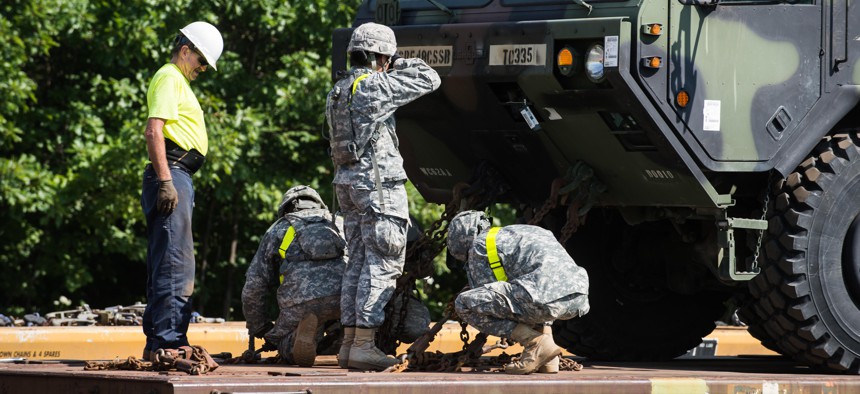
Soldiers of the 10th Mountain Division work with a civilian during railhead operations at Fort Drum, N.Y., July 28, 2015. Photo by U.S. Army Staff Sgt. Michael K. Selvage
Putting Civilians in US Troop Support Jobs Could Save Billions, Report Says
Converting 80,000 active-duty jobs to civilian positions could save as much as $5.7B per year, according to a new Congressional Budget Office analysis.
Replacing military personnel in Defense Department support jobs with civilian employees could eventually save the federal government billions annually, according to a new Congressional Budget Office analysis.
Converting 80,000 full-time jobs held by active-duty service members to civilian positions could yield between $3.1 billion and $5.7 billion per year in eventual savings, the nonpartisan CBO estimated. CBO analyzed compensation costs, including pay, health insurance, and other benefits that military personnel and civilian employees receive.
“CBO estimates that if all the services adopted the approach of the service with the smallest percentage of military personnel in each commercial occupation, about 80,000 active-duty positions could be available for conversion,” the analysis said. CBO said the services could consider conversion as a way to help them comply with sequestration.
In 2012, approximately 340,000 active-duty service members were in commercial support jobs. Some of the jobs CBO looked at included positions in communications, finance and accounting, health services, and logistics. The amount of savings to the government from converting those jobs would depend on the department’s replacement ratio; the savings are greater if Defense replaces every three service members with only two civilians, for instance, rather than replacing everyone in equal numbers.
The analysis showed that the federal government overall would see greater savings than would Defense individually from replacing military personnel with civilian employees. A civilian worker in one of DoD’s commercial jobs costs the government 29 percent less than an active-duty service member, roughly $96,000 annually versus $135,200. That’s largely because the costs of military personnel – from pay to retirement to veterans’ benefits – are spread out across multiple agencies. However, a civilian employee costs the Pentagon about 3 percent more than an active-duty member in the occupations that CBO looked at, about $106,100 per year compared to $103,400, in part because civilian salaries tend to be higher in the positions CBO reviewed.
“Active-duty service members cost less to DoD than to the federal government as a whole in large part because a significant portion of their costs is borne by agencies other than DoD,” the analysis said. “In contrast, civilian employees cost more to the DoD than to the government as a whole because very few of their costs are borne by other agencies and because their higher taxable incomes generate larger tax payments to the Treasury.”
According to CBO, replacing one service member with a civilian employee would on average increase the taxes the employee owed by about $6,600 per year.
Defense periodically reviews the make-up of its workforce, converting noncombat military positions to civilian jobs, although the individual services decide on their specific military-civilian blend. For example, in 2012, military personal accounted for 4 percent of the Navy’s motor vehicle transportation workforce, but 74 percent of the Air Force’s workforce in that field.
“Some service officials attribute part of the variation to the unique missions of each service that require them to use personnel differently,” CBO said. “Other service officials also point to an existing military culture in which officials prefer to use military personnel rather than civilians for certain functions.”
Direct combat jobs are restricted to military personnel, while “inherently governmental” positions typically are open to both military and civilian staff. Commercial jobs include those restricted to Defense military and civilian employees, as well as other jobs open to contractors. Civilians make up about one-third of the department’s workforce. Between 2004 and 2010, Defense shifted roughly 48,000 military jobs to civilian employees and some contractors – about 32,000 civilian workers replaced military personnel.
CBO noted that civilians bring “greater job stability” because they move less often than service members, and typically require less on-the-job training. But the nonpartisan CBO also said that DoD and policymakers should carefully consider the factors in converting military jobs to civilian positions. “Achieving the savings from the conversions as discussed in this report would require DoD to reduce end strength by the number of positions transferred,” the analysis said. “Doing so, however, could reduce DoD’s ability to rapidly increase the number of troops when it is engaging in combat operations that last for several years.”




